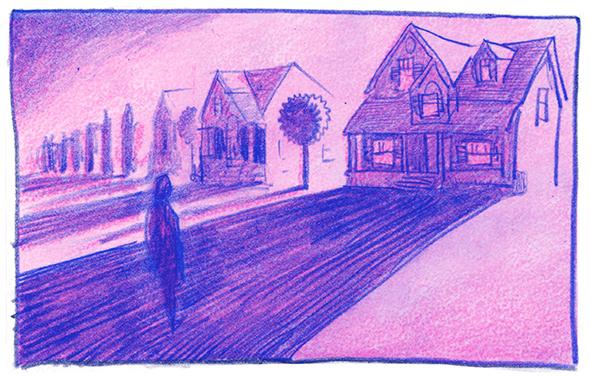You can blame Cheever for it, or Updike, or Yates. Those midcentury men strip-mined the suburb for every last bit of banality and unhappiness it contained. And as their books leached out into the wider culture, into American Beauty or Mad Men, we lost all surprise that behind the prosaic exterior lurked sexual dysfunction, depression, and even corruption. The idyll of the suburbs no longer exists in fiction. Every cookie-cutter house is vaguely sinister; we expect ugly, dark things to come up through the grass.
At this point even the memory of my own calm suburban childhood feels filtered through that lens. I remember the well-paved sidewalks and good schools. But those memories are overshadowed by the older man who followed girls home from school.
René Steinke’s new novel Friendswood suggests that she feels the same way. The book is named for the relatively cheerful-looking Texas suburb in which it is set, and the press packet says Steinke herself grew up there. Steinke is not here to rehash fond memories, though. Her Friendswood is a place already ruined. It has experienced one disaster—a leak of toxic chemicals into the soil—and another, a gang rape, is just on the point of happening.
The mood is decidedly after-the-Fall from the prologue onward:
The air did not yet smell of dead lemons. The red and blue sores hadn’t yet appeared on anyone’s neck. The black snakes hadn’t wriggled up from the ground. And she had no idea that this world was not without an end.
Steinke has a flair for lyrical turns like that, but Friendswood suffers from structural problems that her facility with language cannot rescue. It is a two-plot affair, and, nearly from the beginning, that’s a bother. Perhaps Steinke hoped the loading up of tragedy would deliver a double gut-punch, elevate her book. Instead, one plot thread, the trail of the environmental disaster, suffers in the shadow of the more uniquely and powerfully drawn sexual assault.
In a way it’s odd that the environmental disaster should be the less compelling story, since its reach is so much wider. The book can be vague on the precise details of it, but suffice to say that runoff from an oil refinery eventually turned a whole neighborhood in Friendswood into a Superfund site. And not only property was damaged and abandoned. One main character, Lee Knowles, is obsessed with tracing the aftermath in part because her daughter, Jess, died of a blood infection she’s convinced was connected.
The problem for the reader is we don’t know Jess beyond a few tosses of glossy curls; the reader is asked to invest instead in Lee’s quest to stop a crooked developer from redeveloping the site. The plot-heavy nature of that doesn’t play to Steinke’s talents. Her elegant turns of phrase are no help to her when she has to describe the prosaic day-to-day of Lee’s fight. In fact, sometimes she seems to be sensing her own reader’s reaction to Lee’s obsessions: “People’s eyes glazed over, reading the data, but when she could get someone’s attention at an agency, or on the city council, she felt the ground steady beneath her.” Even when the drama eventually ratchets up for Lee, it has a rote quality; she plays a cliché, as do her opponents.

Photo by Michelle Ocampo
And yet there is so much to admire in the way Steinke handles the other story in her book, which allows her to go deeper into a character’s interior life.
Even before Willa wakes up drugged, confused, and alone in a strange bedroom, she is having visions: cameras and lions’ manes appearing in her bedroom ceiling. From the get-go, she’s an odd girl, or perhaps more accurately, an acolyte of Odd Girls. Willa is obsessed by women dead long before her, one a survivor of the Alamo named Susanna Dickinson, the other New England poet Emily Dickinson. As a coping mechanism she looks up facts about the latter on the Internet:
She liked white dresses. She attended Mount Holyoke Seminary, but left for mysterious reasons. After a certain age, she didn’t like to greet people at the door. She had a dog for sixteen years, and when he died, she mourned him. She only attended church for a few years, and never made a formal declaration of faith. At some point, she wrote to a friend, “Home is so far away from home.”
The figure of Emily Dickinson, comforting in loneliness, does not quite manage to fight off Willa’s pain. For both of them, eccentricity, not quite a salve, instead leaves them on the edge of madness. In the aftermath of the assault Willa can’t shake off certain hallucinations. Some seem connected to biblical imagery, a lamb and a dog. She keeps writing verses on her body, and then scrubbing them off. The only thing that truly seems to heal her is time. When the book tries to suggest that Willa is inspired by Lee’s example, it grows stilted again.
To anyone who’s read Steinke before it is not really surprising that it is in Willa that she’s really able to play to her strengths. Her last novel, Holy Skirts, reimagined the life of another kind of Odd Girl, the artist/poet/proto-flapper Elsa von Freytag-Loringhoven. She has a knack for drawing the interiority of women who are a bit off the beaten track.
But you begin to resent the book whenever it tears you away from Willa. She is the only character with an interiority that feels worth staying with. The boys who assault her are comparatively thin things, one bent hard by guilt and the other obsessed with saving her. In Steinke’s efficient depiction of Willa’s psychology, Friendswood successfully inverts a familiar suburban parable. Usually, we know these stories only through the lens of whatever punishment (often slim) gets meted out on the young men in these situations. The young women, for otherwise honorable reasons, remain ciphers to us under cover of anonymity. Willa is not an everygirl who can fill in all their blanks, of course. Steinke simply gives her enough identity of her own to suggest that the real lesson is that such things meet people, and hurt them, just where they are. That is a Cheeverian move, taking an outline and filling it with something recognizably human. I simply wish Steinke had spent her whole book doing it.
—
Friendswood by René Steinke. Riverhead.
See all the pieces in this month’s Slate Book Review.
Sign up for the Slate Book Review monthly newsletter.
